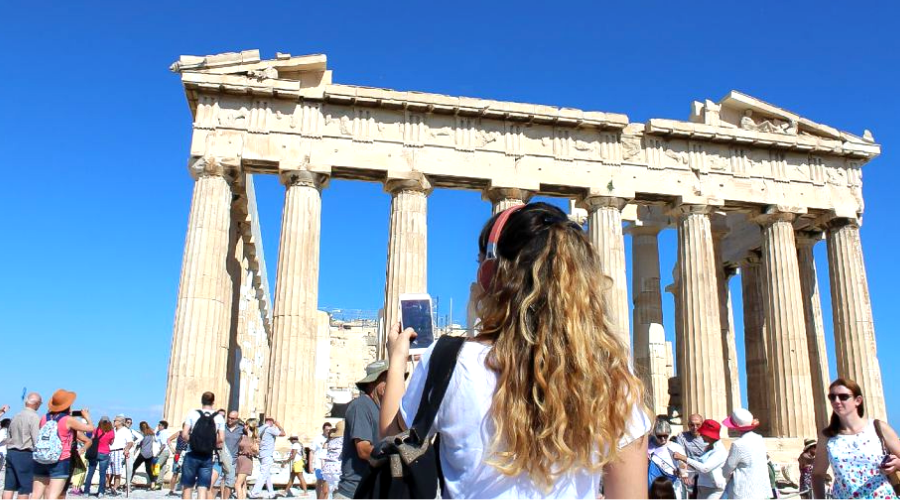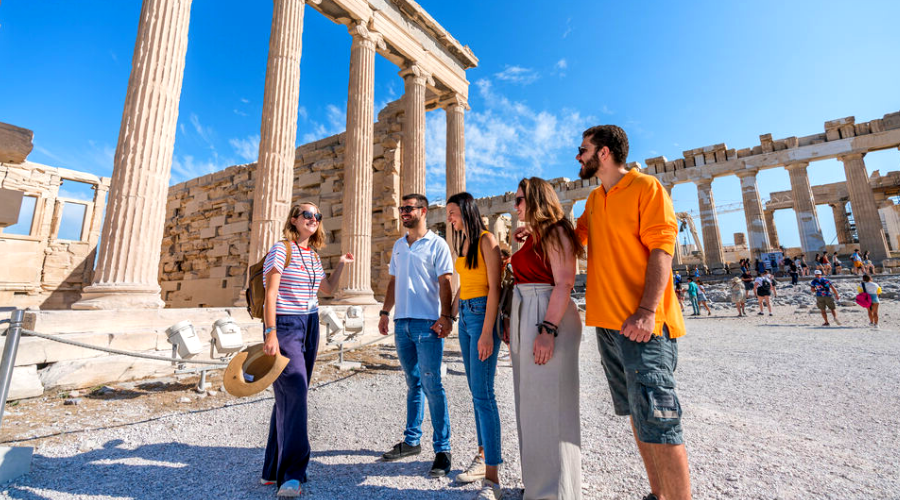Did you know that over 2.5 million people from around the globe flock to the
Key Takeaways
-
Discover the
Acropolis location — a historic epicenter of ancient Greek culture in the heart of Athens. -
Immerse yourself in the grandeur of Acropolis Athens Greece — where the past is palpable in every stone.
-
Learn about the
Acropolis archaeological site. Its extraordinary contributions make Greek architecture renowned. -
Experience the pivotal role of the
Acropolis in shaping Western civilization, making it a must for visiting theAcropolis . -
Soak up the ambiance of Athenian history through its most compelling landmark, reflecting the essence of a bygone era.
 The Official Ticketing Site for Acropolis Tickets online | GUIDE 2024
The Official Ticketing Site for Acropolis Tickets online | GUIDE 2024
Before Purchasing from the official website of the Greek government Please Note
Unveiling the Acropolis : Stepping Back in Time
Imagine wandering through the ancient
Embark on a Historical Journey
As you set foot on the storied grounds, you’re immediately swept into a world where history and mythology intertwine. The
The Significance of Greek Architecture
In the presence of the
Your exploration of the ancient
 Acropolis and 6 Archaeological Sites Combo Ticket
Acropolis and 6 Archaeological Sites Combo Ticket
- Skip-the-line
- Free cancellation.
The Acropolis Location: A Guide to Finding Ancient Greece in Modern Athens
Immerse yourself in the splendor of Ancient Greece. Trace your way through bustling streets to the timeless
As you navigate Athens, look for signposts and landmarks. They are integral to the city’s identity and also guide the
| Athens Landmark | Description | Proximity to |
|---|---|---|
| Syntagma Square | The central square of Athens is filled with historical significance and vibrant energy. | A pleasant walk through the National Garden away from the |
| Plaka District | A picturesque neighborhood known for its charming streets and neoclassical architecture. | Adjacent to the northern slope of the |
| Monastiraki Flea Market | A bustling marketplace that captures the essence of Athenian commerce and culture. | Just a stone’s throw from the |
As you take each step towards
Remember, the journey to the
Exploring the Grounds of Acropolis Hill
As you ascend the ancient path towards
The Majesty of Its Geographical Setting
Like a sentinel,
A Panoramic Vista of Athens Landmarks
When your gaze drifts over the edge, you’re greeted with a breathtaking panorama. It connects the ancient and the contemporary. The sweeping views from
Indeed, visiting the
Visiting the Acropolis : Tips for the Modern Traveler
Embarking on a journey to the Acropolis of Athens Greece is like stepping into a page from history. To make the most of your visit to this ancient citadel atop the Acropolis Hill, a bit of planning goes a long way. Here are some travel tips to ensure a memorable and hassle-free experience.
First, timing is key when visiting the
Understanding your ticket options is crucial. It’s best to buy your tickets online in advance to skip the long lines. Keep in mind that several ticket packages are available. They cover other historical sites in Athens. They can offer savings for the avid explorer.
-
Buy entry tickets in advance online
-
Choose a ticket package for many sites if you plan extensive visits
-
Plan your visit around the early morning or late afternoon hours
As you navigate the ancient pathways of the
| Tip | Details | Benefit |
|---|---|---|
| Best Time to Visit | Early morning or late afternoon | Fewer crowds, better lighting |
| Ticket Purchase | Online in advance | Skip the lines, secure entry |
| Suggested Routes | Follow outlined pathways | Comprehensive tour of sites |
| Footwear | Comfortable, non-slip shoes | Safety and comfort on uneven terrain |
Remember to stay hydrated and protect yourself from the sun with a hat and sunscreen. Above all, don’t forget to pause and breathe in the ancient air. Cherish the panoramic views over Athens. You can see it all from the magnificent
Discovering the Acropolis Archaeological Site
The
Insight into Excavations and Discoveries
Archaeological efforts at the
-
Encounter the intricately carved metopes and friezes at the Parthenon. They capture the essence of Greek mythology.
-
The Erechtheion Complex: Marvel at this temple’s complex design. The archaeological finds hint at its rich ceremonial past.
-
Statues and Artifacts: You can stand face-to-face with the marble statues and everyday artifacts. They offer glimpses into the daily life of ancient Athenians.
Understanding Conservation Efforts
As you witness the grandeur of the
Each conserved stone and stabilized column is a testament to our commitment. We honor our ancestors and share their legacy with the world.”
The fusion of past and future is palpable at the
Acropolis Athens Greece: A Blend of Culture and Mythology
When you set foot on the storied grounds of the
The
| Echoes of Myth | Historical Significance |
|---|---|
| Home of the gods on Mount Olympus | Religious center and symbol of Athenian democracy |
| Battle between Athena and Poseidon | The founding myth represented on the Parthenon frieze |
| The legendary King Erechtheus | Erechtheion named in his honor |
| The Propylaea as a gateway for the gods | Monumental entrance to the sacred precinct |
As you explore this cradle of Greek culture, it becomes clear that the
-
Marvel at the Parthenon, where the gods once tread according to lore.
-
Stand in the Erechtheion, amidst the sacred marks of Poseidon’s trident.
-
Contemplate the enduring legacy of mythical battles and cultural triumphs.
The
Ancient Acropolis : Delving into Its Rich History and Origins
Your journey brings you to the formidable gates of the ancient
From Ancient Times to the Hellenistic Period
This section invites you to explore the lineage of the Ancient
The Stories Behind the Stone
With every step on this sacred ground, you are walking atop layers of stories. Western civilization has etched them into its bedrock. Each stone at the
| Epoch | Influence on |
Significant Developments |
|---|---|---|
| Classical Antiquity | Construction of major structures; pinnacle of Greek architecture | Erection of the Parthenon and other monumental temples |
| Hellenistic Period | Expansion and artistic embellishments; cultural interchange | Rise of Athens as an academic and cultural hub |
| Roman Conquest | Preservation and adaptation of Greek cultural elements | Incorporation of |
Marvels of Greek Architecture: The Pillars and Edifices
The Golden Age of Athens left a mark on history. It did so through its impressive Greek architecture. This legacy is most evident within the ancient walls of the Ancient
Let’s focus on some specific aspects:
-
The Parthenon, a structure that has stood the test of millennia, showcases the Doric order. It is both a pillar of strength and a beacon of beauty, resonating the prowess of its architects.
-
The Erechtheion, which is particularly famous for its Porch of the Caryatids. In Greek architecture, sculpted maidens support the structure of Ionic columns. People know the maidens as the Caryatids. They give the columns a feminine form. They symbolize the combination of innovation and tradition.
Amidst these monumental edifices, you are not just a spectator. You are a traveler through time. Every structure tells a story of an era. Mythology and democracy entwined form and function. To truly honor the marvels of these classical architectural feats is to appreciate them in their historical context. Nestled high above Athens, they were once the center of a vibrant civilization. Now, they look out over a modern metropolis.
Furthermore,
Seeing the Greek architecture of the
Acropolis up close is like observing the blueprints of history’s master builders. Their ancient techniques and artistic visions continue to inspire centuries of architectural endeavors.
In conclusion, when you visit the
Experiencing the Acropolis Museum: Artifacts and Exhibits
After marveling at the splendor of the
The museum is a harmonious fusion of glass and concrete. It celebrates both the old and new Athens landmarks through its thoughtful design. This design allows for natural light to highlight the exhibits’ majesty. As you peruse the spaces within, you encounter a world where worship, art, and the Athenian spirit come alive. Here, the passage of centuries disappears. You find yourself immersed in the vibrancy of a civilization long past. It is never forgotten. Avant-garde preservation technologies amplify the illusion. They present these relics in their best light.
Embrace the privilege to witness the detailed carvings and sculptures. They speak volumes of the Hellenic legacy. From votive offerings to marble statues, each piece tells a unique story of its era. The pieces reveal the human aspects behind the immense historical significance. The
FAQ
How do I find the location of the Acropolis in Athens?
Athens, Greece, has the
What is so significant about Greek architecture at the Acropolis ?
For centuries, people have copied the columns, geometry, and symmetry of Greek architecture at the
Can you see other Athens landmarks from the Acropolis ?
When you’re atop
What tips do you have for visiting the Acropolis ?
To enhance your visit to the
What can visitors discover at the Acropolis archaeological site?
The
How does the Acropolis in Athens Greece blend culture and mythology?
The
What is the historical significance of the ancient Acropolis ?
The Ancient Acropolis holds significant historical value. It traces its origins back to classical antiquity and the Hellenistic period. Each stone tells the tale of Athens’ ascendance to power. It also shares the city’s cultural and philosophical advancements. And it reveals the enduring legacy of ancient Greece.
When visiting, which elements of Greek architecture should I pay attention to?
When visiting the
What can I expect to see at the Acropolis Museum?
The
 Before you buy tickets, read the guide for 2024. Click Here
Before you buy tickets, read the guide for 2024. Click Here


